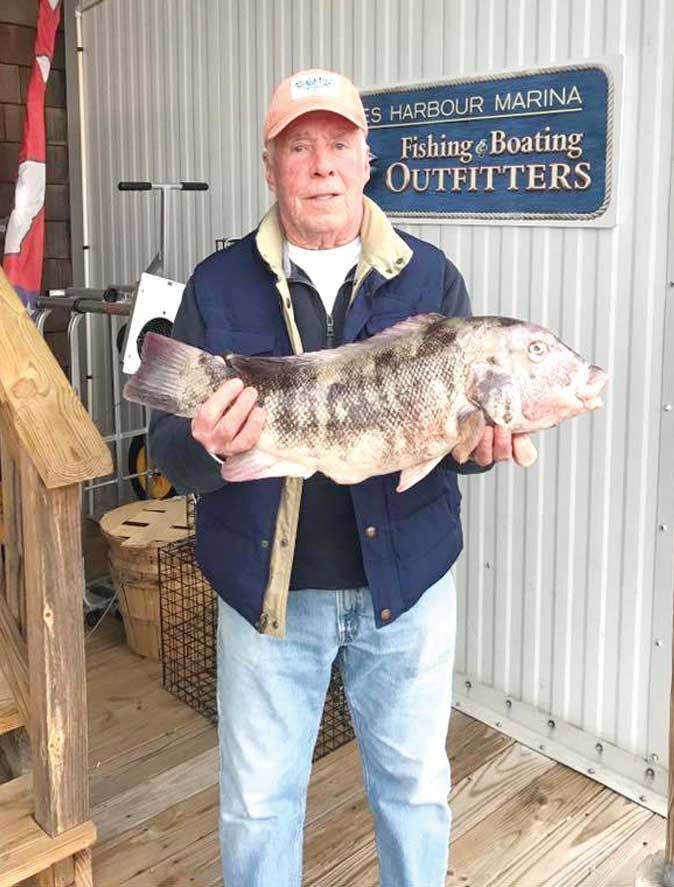Unless you can afford to live in Florida or some other warm climate location during the winter, you will have to forgo fishing until spring and more comfortable outdoor temperatures return. I realize there are a few misguided souls that will venture out on a frozen lake or river with tiny rods and sticks to drop a bait or lure through a hole in the ice in an effort to catch a perch, pickerel, or perhaps a trout. As my grandfather would say, “These folks just ain’t right in the head.” No fish known to man would get me out there even when I was young and certainly not now in my Golden Years.

There are, however, fish that will get me outside during the winter. Tog or tautog are found in the ocean and may be caught out of Lewes and Indian River, DE; Ocean City, MD; as well as Virginia Beach, VA. These are tough little critters, and they live in tough neighborhoods. They are not very pretty by human standards, but they make for great table fare.
Of course, you have to catch one before you can eat it, and therein lies the problem. Unlike most of the fish we target, tog do not take their food into their mouth right away. The first thing they do is crush the crab, mussel, or other hard-shell food source, spit out most of the hard parts, and then swallow the soft parts. This all happens in the blink of an eye. I have watched tog feed at the Virginia Aquarium in Virginia Beach, and the speed they accomplish this activity is amazing.
For the angler trying to catch a tog it is important to stay in touch with what is going on at the end of your line. Braided line has been an important tool in this regard with its no stretch and thin diameter. Even with braided line, the angler must still keep his or her total attention on the task at hand and be ready to set the hook at the slightest tap from below.
Keeping the line at a 90-degree angle to the water will help the cause. This not only shortens the distance from the hook to the angler, it also helps to keep the rig out of the structure. I constantly lift and drop my rig just an inch or two while fishing. This keeps me in contact with the bottom and lets me feel even the slightest change in weight on the end of my line.
I love circle hooks, but they offer no advantage when tog fishing. Circles work by going in the mouth of the fish and grabbing the corner latch on the way out. Since the hook seldom if ever gets inside the tog’s mouth, it can’t do the job it was designed for.
Tog are not picky eaters. They graze along the bottom and over wrecks, rocks, and other hard structure looking for mussels, crabs, worms, clams, and lobsters. The most popular baits are green crabs, white leggers, shrimp, clam, conk, and sand fleas. I have caught tog on Gulp! peeler crabs and on a Stingsilver. Both times I was using those artificials for black sea bass.
I only use one hook when tog fishing. I tie a bottom rig out of 30-pound leader material with a perfection loop on one end and a double surgeon’s loop on the other. In the middle I tie another surgeon’s loop for the hook. The sinker goes on the bottom loop, and I snap the top loop to my 50-pound Fluorocarbon shock leaded. The completed rig is about one-foot long with the hook as close to the middle as possible.
Tog jigs are something new to this fishery. They are lead jigs with a flat bottom and a hook that points parallel to the body of the jig. The idea is the jig will sit flat on a rock or other structure with the baited hook ready for the tog and somewhat protected from entanglement in the structure. I purchased a few of these jigs, but have yet to try them.
I don’t recommend taking your boat out tog fishing unless you have a good knowledge of ocean structure and your boat has a cabin that can protect everyone from the cold. Charter and head boats run all winter from the ports mentioned and are much more comfortable and safer than any boat you can fit on a trailer.
By Eric Burnley